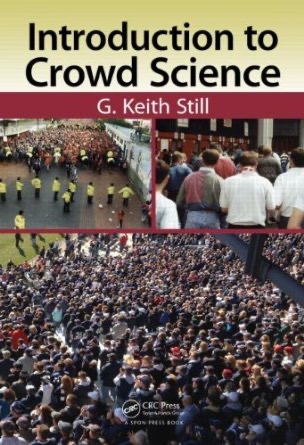
This is our old website - we are in the process of updating all the information on this site. For current information - check out our main site at
_________________________________________________
Click here for information on our eLearning version of “Introduction to Crowd Science”
_________________________________________________

Click on the book graphic for a link to purchase
"Dr Still, I am 3/4 of the way through your book, Introduction to Crowd Science, it is absolutely brilliant. I have been able to use the content instantly.” (Australian Police Inspector, Public Order Division)
You can link to the publishers site by clicking on the book image (right)
Chapter list
1. Introduction
3. Causality
4. Crowd science. The four core tools (DIM-ICE risk model, RAMP Analysis, Risk and Congestion Mapping and the Decisions Support Analysis matrix)
6. Case study examples
7. Control room applications (real-time decision support)
8. The way forward
Appendices
a. Essential crowd safety mathematics
_________________________________________________
Sample excerpts from the introduction to the chapters.
Chapter 1 - Introduction (excerpt)
"Someone who builds a mathematical model can get carried away with all the clever things that can be done with it. The model becomes a safe little world, free from anxiety, free from office politics, rewarding in its own right. This often results in a very clever model that has little to do with reality." (Sam L. Savage, author of INSIGHT.xla: Business Analysis Software for Microsoft Excel)
This is not a book about the clever things you can do with a computer. Nor is this book about deep scientific discussion and argument, complex mathematical techniques, simulations or computer technology. In fact, we argue that crowd simulations must be used with extreme caution when applied to major events – particularly if they relate to crowd safety.
This is a book about how to apply simple, practical techniques to help you understand crowd risks and improve crowd safety. Specifically, this is a book in which we outline how to apply a range of tools and techniques to help you plan for crowds in places of public assembly. We outline case studies where these tools have improved our understanding of event risk analysis and made a significant improvement to crowd safety. We explore the underlying causes that can lead to mass fatalities, and provide the reader with a comprehensive, methodical, systematic and safe approach to crowd risk analysis and safety engineering. The aim of this book is simple: to improve your understanding of crowd risk; to help you plan for, and manage, your crowds safely.
Chapter 2 - Crowd risk analysis (excerpt)
"A wise man learns by the mistakes of others, a fool by his own." (Latin Proverb)
“Human beings, who are almost unique in having the ability to learn from the experience of others, are also remarkable for their apparent disinclination to do so”. (Douglas Adams)
Introduction
One of the more interactive demonstrations we use in the workshops is a series of density experiments using a fixed area. These are important for the delegates to understand both the physical (number of people per square metre) and psychological (how it feels) factors in crowded spaces. The experiments illustrate a common failure in event planning: the temptation to focus on capacity and not on how the spaces are going to be used. We may, for example, have a vast area available for an event but still experience crowd crushing problems if the stage area is badly designed, or entry and exit systems are not suitable arranged, wide enough or have sufficient throughput capacity. Those kinds of problems can occur at pinch points in and around the event site. In this chapter, we shall build up a series of models for both static and dynamic spaces; areas where the crowd is predominantly stationary (static) and where it is predominantly moving (dynamic) to assist the event planner, licensing officer and operations teams to recognise crowd risks.
Chapter 3 - Causality (excerpt)
“Shallow men believe in luck or in circumstance. Strong men believe in cause and effect.” (Ralph Waldo Emerson, Essayist, 1803 - 1882)
"We learn from history that we do not learn from history." (Georg Wilhelm Friedrich Hegel, Philosopher, 1770–1831)
Introduction
In this chapter, we examine causality of crowd related incidents, with specific focus on the reasonably foreseeable crowd risks for planned events. One of the first questions we are asked, during expert witness cases, is “was the incident reasonably foreseeable?” and “at what point in time could the incident have been avoided/averted”.
As we defined in the opening chapters of this
book, the event process can be split into three distinct phases, planning,
approval and operations. To answer the questions above we need to review the
concept of “reasonably foreseeable” in the context of a layperson, an
adequately trained crowd manager, a licensing officer/inspector and an expert.
Chapter 4 – Crowd science (excerpt)
"The sciences do not try to explain, they hardly even try to interpret, they mainly make models. By a model is meant a mathematical construct, which, with the addition of certain verbal interpretations, describes observed phenomena. The justification of such a mathematical construct is solely and precisely that it is expected to work - that is correctly to describe phenomena from a reasonably wide area. Furthermore, it must satisfy certain aesthetic criteria - that is, in relation to how much it describes, it must be rather simple." (John von Neumann: Hungarian-born Mathematician, 1903-1957)
In this chapter, we introduce several modelling techniques for crowd and event risk analysis. Specifically, the DIM-ICE risk model (based on past incidents and accidents to highlight areas you need to focus on in your event planning process), the RAMP analysis (where the crowd dynamic, routes, areas, movement of people over time and profile of the crowd are considered), the Risk and Congestion mapping process (this is a graphical representation of the crowd dynamic) and the decision support analysis (used to assess strategic and tactical options). These techniques have been developed over a decade of working on many different projects and teaching programmes, and have been applied to crowd and event safety around the world. They are neither theoretical nor academic constructs; they are tried and tested methods. We have applied these techniques to a wide range of events, from small crowds to vast gatherings, and have taught over 6,000 delegates the associated principles and applications for use at their own events.
Chapter 5 – Crowd and event modelling (excerpt)
"Truth is ever to be found in simplicity, and not in the multiplicity and confusion of things. As the world, which to the naked eye exhibits the greatest variety of objects, appears very simple in its internal constitution when surveyed by a philosophical understanding, and so much the simpler by how much the better it is understood." (Isaac Newton)
"Divide each difficulty into as many parts as is feasible and necessary to resolve it." (Descartes)
A model is the simple representation of a complex process. Models contain the key elements of a system under study, and most good models begin with the modeller breaking down a complex process into a series of parts. These parts should be focussed on one or two issues and not be overly complex. Models should be simple to construct, simple to visualise, simple to manipulate and they should communicate the key elements of the system under study to both the modeller and other interested parties. In the context of crowd science, the models we develop are aimed towards understanding crowd risks; they should assist in identifying those risks with the aim of eliminating, reducing, mitigating or managing them.
______________________________________________________________
There are four core tools described inthe book: the DIM-ICE risk model, RAMP Analyiss (Routes, Areas, Movement, People/rofile), Risk and Congestion Mapping, and the Matrix approach to strategic and tacitcal deciion support (Decision Support Analysis).